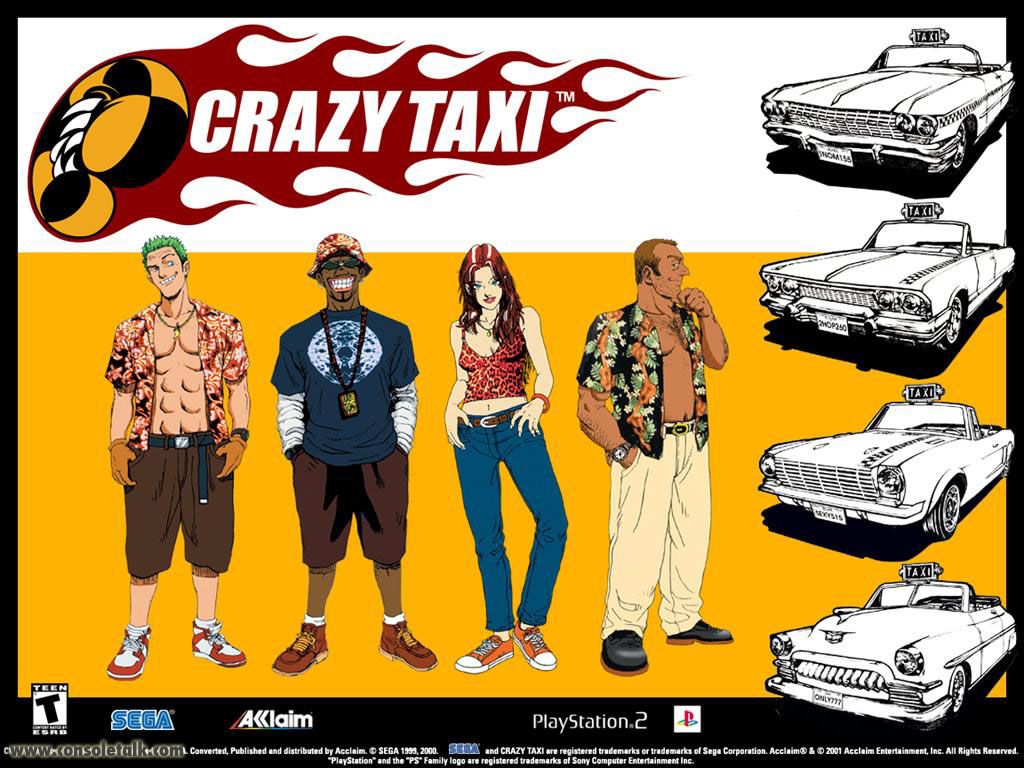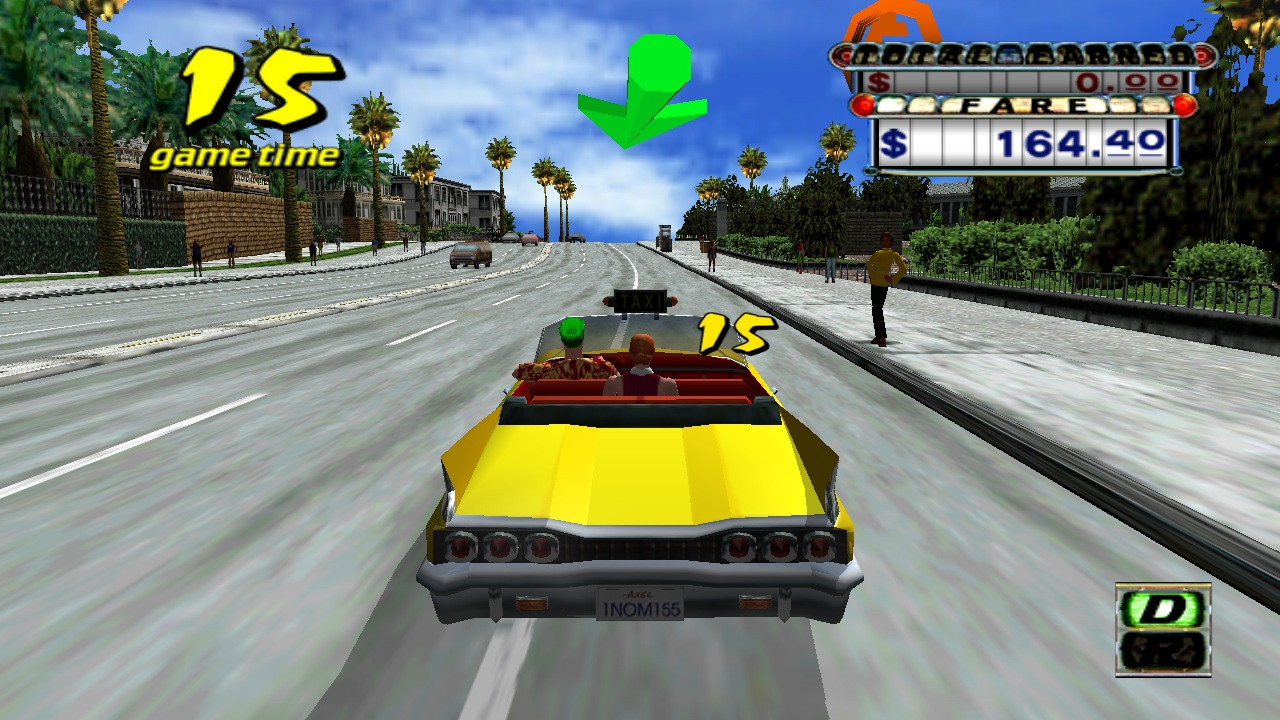
Crazy Taxi is an open world racing video game developed by Hitmaker (Sega AM3) and published by Sega.[4] It is the first game in the Crazy Taxi series. The game was first released in arcades in 1999 and was ported to the Dreamcast in 2000. Subsequently, it was ported to the PlayStation 2 and Nintendo GameCube by Acclaim in 2001, and then Microsoft Windows in 2002. The game was released on November 16, 2010, for the PlayStation Network and on November 24, 2010, for the Xbox Live Arcade. It is featured on the Dreamcast Collection. An iOS version was released on October 10, 2012.[5]
Reception to Crazy Taxi has been mostly positive and it became one of the few Sega All Stars. It has also earned Greatest Hits status on PlayStation 2 and Player's Choice status on GameCube. Sega followed up on the success of Crazy Taxi by making a sequel, Crazy Taxi 2 for the Dreamcast, which included several gameplay changes. It would also be bundled with Crazy Taxi 2 in Crazy Taxi: Fare Wars, and later be bundled with other Dreamcast hits in Dreamcast Collection. Crazy Taxi 3: High Roller was released for the Xbox on July 23, 2002, and later released as a PC title in 2004.
The main objective of the game is to pick up customers and take them to their chosen destination as quickly as possible. Along the way, money can be earned by performing stunts such as near misses with other vehicles.[6] The player is directed to a destination by a large green arrow at the top of the screen. The arrow does not adjust based on obstacles, but rather points in the general direction of the destination. Once the player arrives near the destination, they must stop within a specified zone. When the destination is reached, that customer's fare is added to the player's total money earned. Ratings are then awarded depending on how long the player took to complete the journey.[7] If the customer's timer runs out before the player reaches the destination the customer jumps from the taxi.
Players can select three, five or ten minute settings, or the Arcade Rules used in the original coin-op version of the game.[7] In the three time-limited settings, play continues for the designated period of time, after which the cab automatically stops and no more points can be scored. Under Arcade Rules, the player starts with an initial time limit of one minute, which can be extended through time bonuses earned for quick deliveries. Console versions of the game also feature a mode known as Crazy Box, a set of minigames that feature challenges such as picking up and dropping off a number of customers within a time limit, bowling using the taxi as a ball, and popping giant balloons in a field.[8]
The arcade version of the game includes one stage, and an additional "Original" stage was added for the console versions. Both stages are based in sunny coastal California locales, with steep hills and other strong similarities to San Francisco. The player has a choice of four drivers and their cabs, each of whom has slightly different attributes.
he arcade game was developed by Hitmaker as a variation from then-current arcade titles. The Crazy Taxi cabinet ran on Sega Naomi hardware.[3] It was originally released in arcades as a sit-down machine.[9] An upright version was later released.[10] Over the next few years, the game would be ported to the Dreamcast, GameCube, PlayStation 2 and Microsoft Windows. The ratings board for South Korea revealed on June 1, 2010 that the game was rated for release on Xbox Live Arcade.[11] On June 10, 2010, Sega officially announced Crazy Taxi would be one of several Dreamcast titles to be released for the PlayStation Network and Xbox Live Arcade, and that it would be available in Fall 2010.[12] These ports originally were to force a 4:3 aspect ratio, with widescreen monitors showing blue bars on either side of the screen.[13] In October 2010 it was announced that Crazy Taxi would feature full widescreen support.[14] The game is a port of the Dreamcast version, including both the original arcade and the Dreamcast-exclusive level.[14] The PlayStation Network port was released November 16, 2010, while the Xbox Live Arcade version was released the following week.[15]
In October 2012, Sega announced that Crazy Taxi would be brought to the App Store on iOS devices. The game includes the arcade map and the map introduced for consoles. It also includes all Crazy Box challenges. As in the console versions, if all challenges are completed, a pedicab is unlocked to play the main game with. The taxi can be controlled though either the touch screen or by tilting the device making use of its accelerometer. Critics were impressed with this port as the maps remained unchanged and the controls were intuitive.[16]
Sega applied for and was awarded U.S. Patent 6,200,138–"Game display method, moving direction indicating method, game apparatus and drive simulating apparatus" – in 2001.[17] The mechanics in the "138 patent" describe an arcade cabinet similar to Sega's previous arcade game Harley-Davidson & L.A. Riders (1997),[18] but also describe the arrow navigation system and pedestrian avoidance aspects that were used in Crazy Taxi.
Most versions of Crazy Taxi were generally well received by critics. The Dreamcast version of Crazy Taxi was critically acclaimed, averaging 90.19% at video game aggregate site GameRankings based on 37 reviews.[36] Subsequent ports of the game have suffered a trend of declining average scores. The PlayStation 2 port averaged 78.72% at GameRankings and 80/100 at Metacritic, respectively.[34][39] The next port for the GameCube scored lower, with aggregate scores of 70.46% and 69/100.[32][38] The PC port was the poorest rated of the initial ports, scoring an average of 55.67% at GameRankings.[33] Sales for the game were generally high, with the Dreamcast version being the second largest selling Dreamcast game in the United States in 2000, selling nearly 750,000 units,[42] and both the Dreamcast and PlayStation 2 versions selling in excess of one million units overall.[42] Xbox Live Arcade sales for 2011 were high with the game moving nearly 100,000 units.[43]
Critics generally praised the overall gameplay. An IGN staff member said "I can't stress enough how addictive this game is."[7] Of the Dreamcast port Game Revolution's reviewer stated "a great arcade game became a good home game."[6] They further noted the game's high difficulty, and added that while the game was difficult it was not frustrating.[6] Michael Goncalves of PALGN added that the game was either a "love or hate" title, adding "if you love it, you will cherish the game and play it to your hearts content."[44] Goncalves also pointed out that the game featured occasional pop up and clipping.[44] Reviews were split across the releases in regards to the game's soundtrack. PALGN cited Bad Religion and The Offspring as a high point of the game,[44] while Game Revolution felt that the tracks were repetitive.[6] GameSpot reviewer Jeff Gerstmann felt that the soundtrack was subjective to personal preference, stating "you'll either want to crank the volume up or turn the music all the way down."[27] In a review for the PC version's altered soundtrack, fellow GameSpot reviewer Andrew Park felt that the new music was fitting for the game.[20]
IGN's Hilary Goldstein called the Xbox Live Arcade release "a mad dash of fun", adding "there's almost no depth to Crazy Taxi, but that's just fine."[31] Goldstein praised the fact that the port stayed true to the original source. However he felt that the lack of the original soundtrack "kills half the reason to pick Crazy Taxi up again."[31] Criticism also pointed to the lack of visual updates such as higher resolution models and textures.[31] GamePro's Dave Rudden also lauded the fact that the port played faithfully to the original. Rudden echoed Goldstein's comments in regards to poor visuals, stating it had "ugly character models and boxy traffic cars."[45] Robert Workman from GameZone praised the game for sticking to its Sega roots; he stated "Crazy Taxi isn’t just a nostalgic trip, but also a wondrous stress reliever and an all-around entertaining game."[46]







| SYSTEM REQUIREMENTS | |
| MINIMUM PC REQUIREMENTS | |
| MINIMUM | |
| Windows 98/2000/ME/XP | |
| Pentium III 500MHz | |
| Celeron 600MHz | |
| Athlon/Duron 500MHz | |
| 64MB RAM (128MB WinXP) | |
| 8X CD-ROM | |
| 640x480 16-bit color display | |
| DirectX 8.1 | |
| Direct3D compatible graphics adapter with 16MB VRAM | |
| 200MB free hard drive space | |
| Keyboard or gamepad, joystick, steering wheel (force feedback supported) | |
| RECOMMENDED | |
| Pentium III 800MHz | |
| 128MB RAM or higher | |
| Direct3D compatible graphics adapter with 32MB VRAM | |
















No comments:
Post a Comment